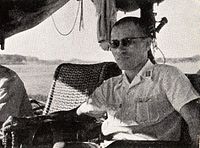Tateo Katō
| Tateo Katō | |
|---|---|

Major General Tateo Kato
|
|
| Native name | 加藤 建夫 |
| Born |
September 28, 1903 Asahikawa, Hokkaido, Japan |
| Died | May 22, 1942 (aged 38) Bay of Bengal |
| Allegiance | Empire of Japan |
| Service/branch | Imperial Japanese Army |
| Years of service | 1925–1942 |
| Rank | Major General (posthumous) |
| Unit | Imperial Japanese Army Air Service |
| Commands held | 64th Sentai |
| Battles/wars | |
| Awards | Order of the Golden Kite |
Tateo Katō (加藤 建夫 Katō Tateo?, September 28, 1903 – May 22, 1942) was a Japanese ace army aviator, credited with at least 18 aerial victories and who was honored posthumously by an award of the Order of the Golden Kite.
Katō was born and raised in present-day Asahikawa, Hokkaidō. His father Sergeant Tetsuzo Katō was killed in the Russo-Japanese War. He graduated from the 37th class of the Imperial Japanese Army Academy in 1925, and enrolled in the Tokorozawa Flying School two years later.
In May 1927, he was posted to the 6th Hiko Rentai (flight regiment) in Pyongyang, Korea. His flying skill with the Kawasaki Ko-4 biplane fighter (a license-built Nieuport-Delage NiD 29) was so outstanding that he was selected to become a flight instructor at Tokorozawa in 1928. In 1932, Katō was promoted to head instructor at the Akeno Flying School, the premier air academy for the Imperial Japanese Army Air Force. In 1936, Kato became commander of the 5th Rentai, and with the outbreak of the Second Sino-Japanese War in 1937, he became commander of the 2nd Daitai, equipped with Kawasaki Ki-10 "Perry" biplane fighters, which quickly achieved air superiority over northern China. Katō claimed nine Chinese fighters during his rotation, making him the top-scoring Army pilot in China during the period 1937-1941.
...
Wikipedia
